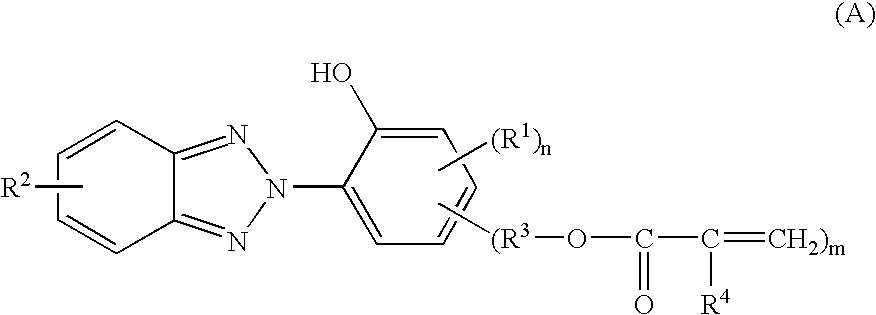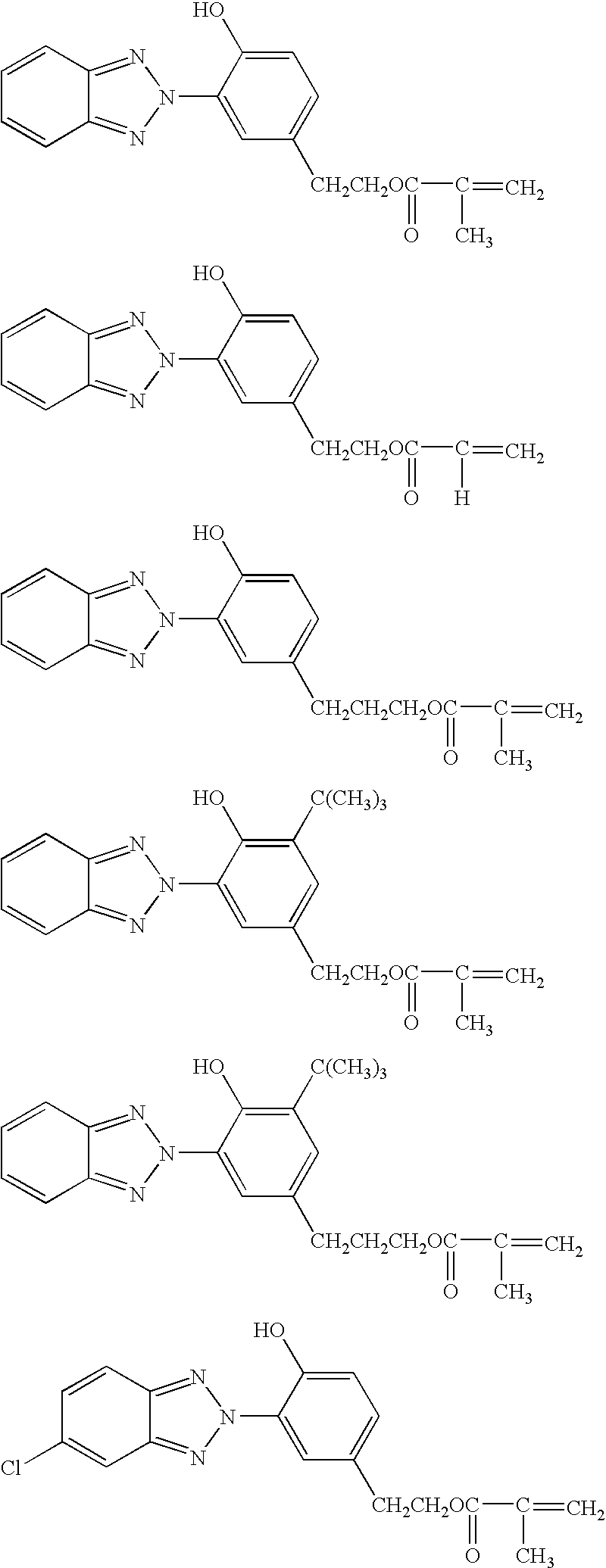Coating composition, coating method, and coated article
a technology of coating composition and coating article, applied in the direction of coating, priming paint, transportation and packaging, etc., can solve the problems of adversely affecting the adhesion to the substrate, unable to add a large amount of uv absorber to the protective coating of colloidal silica-containing polysiloxane, inferior surface properties of polycarbonate resin, etc., to achieve the effect of improving mar and weather resistan
- Summary
- Abstract
- Description
- Claims
- Application Information
AI Technical Summary
Benefits of technology
Problems solved by technology
Method used
Image
Examples
first embodiment
In the invention, the coating composition contains as an essential component the reaction product of a benzotriazole compound having a polymerizable vinyl group and a hydroxyl group with a silane compound and / or a (partial) hydrolyzate thereof. The reaction product results from addition reaction of the silane with the polymerizable vinyl group on the benzotriazole compound.
Any desired benzotriazole compound may be used herein as long as it has a polymerizable vinyl group and a hydroxyl group. In particular, compounds of the general formula (A) are preferred. On the other hand, any desired silane may be used as long as it has a functional group capable of reaction with the polymerizable vinyl group on the benzotriazole compound. Amino group-containing silanes and thiol group-containing silanes are preferred, and in particular, amino group-containing organoxysilanes of the general formula (B) are preferred.
Accordingly, in the first embodiment, the coating composition is preferably def...
synthesis example 1
A 0.5-liter flask equipped with a stirrer, condenser and thermometer was charged with 161.5 g (0.50 mol) of 2-(2′-hydroxy-5′-methacryloxyethylphenyl)-2H-benzotriazole, 89.5 g (0.50 mol) of γ-aminopropyltrimethoxysilane, and 251 g of dimethylformamide, which were stirred and heated at 80° C. for dissolution. At this point, the solution was yellow and clear. The solution was heated to 120° C., at which temperature reaction was effected for 5 hours, obtaining a brown clear solution. By gas chromatography analysis, the disappearance of the reactant, γ-aminopropyltrimethoxysilane was confirmed. The solid concentration was 50.1%. A dilution obtained by diluting the solution with dichloromethane to a solid concentration of 0.05 g / liter was analyzed for absorbance by spectrophotometry, finding an absorbance: λmax 341.4 nm and Abs 1.75, which was substantially identical with the absorbance of the reactant, 2-(2′-hydroxy-5′-methacryloxyethylphenyl)-2H-benzotriazole as analyzed at the same con...
synthesis example 2
A 0.5-liter flask equipped with a stirrer, condenser and thermometer was charged with 161.5 g (0.50 mol) of 2-(2′-hydroxy-5′-methacryloxyethylphenyl)-2H-benzotriazole, 111.0 g (0.50 mol) of N-(2-aminoethyl)-3-aminopropyl-trimethoxysilane, and 272.5 g of dimethylformamide, which were stirred and heated at 80° C. for dissolution. At this point, the solution was yellow and clear. The solution was heated to 120° C., at which temperature reaction was effected for 4 hours, obtaining a brown clear solution. By gas chromatography analysis, the disappearance of the reactant, N-(2-aminoethyl)-3-aminopropyltrimethoxysilane was confirmed. The solid concentration was 49.9%. A dilution obtained by diluting the solution with dichloromethane to a solid concentration of 0.05 g / liter was analyzed for absorbance by spectrophotometry, finding an absorbance: λmax 339.8 nm and Abs 1.66, which was substantially identical with the absorbance of the reactant, 2-(2′-hydroxy-5′-methacryloxyethylphenyl)-2H-ben...
PUM
| Property | Measurement | Unit |
|---|---|---|
| composition | aaaaa | aaaaa |
| weight | aaaaa | aaaaa |
| molar ratio | aaaaa | aaaaa |
Abstract
Description
Claims
Application Information
 Login to View More
Login to View More - R&D
- Intellectual Property
- Life Sciences
- Materials
- Tech Scout
- Unparalleled Data Quality
- Higher Quality Content
- 60% Fewer Hallucinations
Browse by: Latest US Patents, China's latest patents, Technical Efficacy Thesaurus, Application Domain, Technology Topic, Popular Technical Reports.
© 2025 PatSnap. All rights reserved.Legal|Privacy policy|Modern Slavery Act Transparency Statement|Sitemap|About US| Contact US: help@patsnap.com



